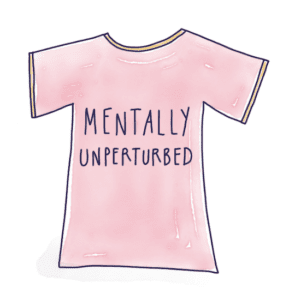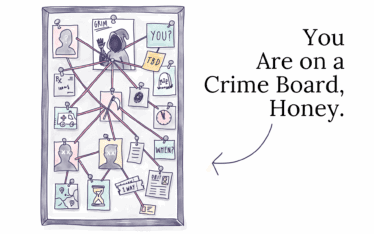First of all, no one really knows what equanimity is, so let me save you from having to Google it:
Equanimity is defined by contemplative science researchers as “an even-minded mental state or dispositional tendency toward all experiences or objects, regardless of their affective valence (pleasant, unpleasant or neutral) or source.”
Said less science-ey, it’s about keeping our shit together when things go both wrong and right. It’s about remaining calm, composed, and impartial just as much when life is a cacophony of craziness as when it’s a deliciously delightful happy high.
Wait, what? Who wants to throw a wet blanket on a happy (and healthy) high? I’m a peddler of the happy (and healthy) high! My 182 blog posts are ALL about living Astonishingly Alive Lives (okay fine—under the looming and ever-present shadow of death—but still), and I don’t mention much about playing it cool when the going’s good.
So what’s the deal?
There is merit to managing our highs and lows. Based in a Buddhist belief system, equanimity appreciates “a balanced reaction to joy and misery, which protects one from emotional agitation.”
Less emotional agitation sounds good, yes?
- When things are unpleasant, we tend to avoid/ deny/ complain/ judge/ scrunch our faces up in disdain. Of course we do. But what if we were equanimous and “gazed upon or observed [the crappy situation] without interference”? What if we didn’t add to the problem with our pesky judgy thoughts, and we kept a cool-headed distance? What would it mean to be level-headed with your next life curveball/ snafu/ shit sandwich?
- When things are pleasant, we tend to cling onto them. Damned right we do! But this tightened grip around the fabulous experience/ person/ donut can lead to manic highs, desperate desires to prolong something fleeting, and addiction. But what if we were equanimity role models and we just let a good time be a good time, or a good thing be a good thing, without craving for more until we wrecked the goodness with our insatiable longing for more? What if we noticed and appreciated the pleasantness without an expectation of its continuance?
If the people over at the HomeGoods stores approached us to start an equanimity retail line, we’d emblazon the following expressions on coffee mugs, beach towels, and shower curtains:
- “You win some, you lose some!” (I’m letting the exclamation point slide because I’m just an exuberant person. Exubanimity describes me.)
- “It is what it is.” (But this has to be said with “it’s cool” tone of acceptance, not the usual passive-aggressive tone of “we have to go along with the strategy because Yohan came up with it— so IT IS WHAT IT IS.” No eye-rolling allowed when reading this saying off a woven doormat.)
- “Go with the flow.” (Old classics never die.)
- “Yin and yang, baby!” (That one might need workshopping.)
What equanimity is NOT . . .
- Feeling checked out and indifferent. Oh, how this point of confusion scares me! Let’s set the record straight in a hurry. Being level-headed is not about being apathetic towards the good, the bad, and the ugly innards of life. It’s not a throw-your-arms-up-in-the-air and crack open a beer kind of attitude when “things go down” (or up!) (although the beer part is fine). Indifference can be seen as a stealth-like form of aversion (not good), whereas equanimity includes attentive care to a situation without emotional entanglement (very good). We can care about and observe what’s going on without getting swept up into the judgmental drama of “this sucks” or “this is the best thing ever.”
- Becoming a stone-cold killer. A synonym that pops up for equanimity is sangfroid, originating from the French words for cold and blood. We are not talking about being cold-blooded here today, friends, because that’s not an ingredient in most lives well-lived. When things go sideways for you or others, equanimity is “not an attitude of cold indifference, but rather of mental imperturbability.” (Can we all agree that mentally unperturbed should be added to the retail line? I’d wear that t-shirt.)
 So how do we become more equanimous?
So how do we become more equanimous?
I’m glad you asked.
- Be careful not to underestimate the value of simply noticing your feelings—where you’re clinging to happiness, when you’re trying to change a less-than-stellar situation. Busting yourself is a powerful first step.
- Re-route your thoughts. Hating that slow driver in the fast lane with all the venom in your heart? After noticing this judgment, try asking yourself what your Most Equanimous Self would think in this moment. “It’s so interesting that I’m annoyed. Is this about him or me?” “There have been slow drivers since the car was invented, and there will be slow drivers until the cars all drive us around.” “In the grand scheme of things, who cares?” “Are my hate beams into his car changing the situation for the better or worse? What if I just didn’t fuss about it?”
- Cultivate a mindfulness practice. Try this winning meditation shared by researchers:
-
- It is considered effective to meditate on three particular individuals personally known by the meditator: one who has done him harm (“enemy” or “difficult person”), one who has benefited him directly (“friend”), and one neutral person (“stranger”). Observing how the mind reacts to thinking about each, the practitioner notices that, upon thinking of the enemy, the mind becomes irritated, resentful, or hateful; upon thinking of the friend, the mind becomes relaxed, comfortable, delighted; upon thinking of the stranger, there is neither irritation nor delight. The next step is to look for the reasons the mind might have for these types of responses. The practitioner will find that “these reasons are in fact superficial and based on narrow, self-serving attitudes.” At this point, “when we view things from a broader perspective with more farsightedness, equanimity will dawn in our minds, enabling us to see the futility of hostility and clinging desire” and to “equalize our feelings toward those three individuals.” The next step in this technique is to “gradually extend the scope of this meditation” to our neighbors, our fellow citizens, and eventually “all the beings in the world.”
-
- Ask yourself, “what would a skillful emotional response be to this situation”? Deep down most of us know there’s a better version of ourselves—that person who reacts with emotional maturity when things are frustrating and fabulous. Be that part of you a little more often than you are today and life will get incrementally better.
Equanimity and death.
All roads lead back to death with me (and I guess you, too, if we’re being literal!), so let’s tie this conversation into The Big Picture.
What might it mean to feel equanimous about your mortality? To approach it with less fear and more openness? To face it with neutrality and curiosity, instead of avoiding it by changing the subject when it gets “too heavy” or when you’d rather refill your wine glass than think about whether you’re leaving a legacy that truly matters to you? Yes to all of the above. Death is part of the deal of getting to be alive, and being level-headed about it means accepting it, contemplating it, counting your Mondays, and living with gusto until you eventually cash your chips in.
For the record: you can still appreciate the gusto-lived life as the Equanimous New You—you just won’t be clinging onto it for dear life, leaving nail marks in its flesh. That sounds delightfully mentally unperturbed to me.

P.S.: We can connect here on Instagram!
P.P.S.: Oh and just in case you missed it… I’d love you forever if you took 16 minutes out of your life to watch my TEDx talk!






